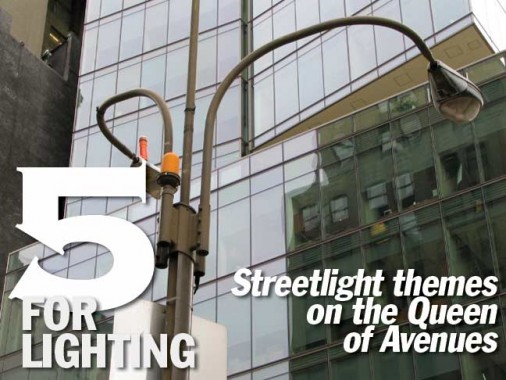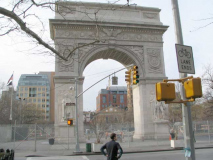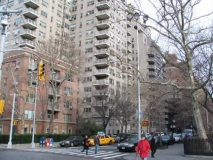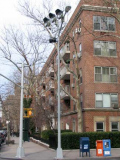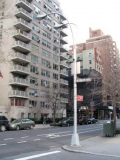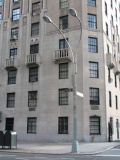Fifth Avenue is, as the late, great Channel 11 St. Patrick’s Day Parade compere Captain Jack McCarthy nicknamed it, the “Queen of Avenues.” It marches in an unbroken line from Washington Square North past the Empire State Building (the King of All Buildings), New York Public Library, St. Patrick’s Cathedral, and Central Park to Marcus Garvey Park, where it takes a 4-block breather, begins again at 124th Street, and runs to 142nd where it meets the Harlem River Drive. It is home to magnificent churches, renowned retail, high-end residences, and innumerable parades besides the one on March 17th.
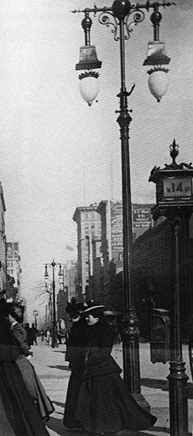
Fifth Avenue has always had “theme” streetlighting.
Property owners on Fifth Avenue complained to The Times in 1892 that Fifth Avenue “suffers at night from darkness almost like that of Egypt,” and the owners were given outdoor lighting by the Edison electric company in 1892. Early photographs and surviving poles show an astonishing array of decorative gewgaws, many hardly visible from the street: pressed metal leaves, small spiral wire finials, scalloped lamp casings.
— Christopher Gray, “Should the City’s Streetlights Be All the Same or Different?”New York Times, September 19, 2004
The photo at left shows 5th Avenue and West 14th sometime around 1900. Many of the ornate details that Gray referred to are in evidence here, especially at the top of the post, which featured a wild array of ornamental detail. At first, each corner got one post. Later, another was placed catercorner to it, and much later, posts were placed mid-block.
These “twins” or “twinlamps” as I called them were later officially catalogued as Type 3 Twins, and a variant later appeared, as we’ll see, that in time nearly supplanted them. But we’re getting ahead of ourselves a little.
The ornate castiron posts were supplanted by wave after wave of other 5th Avenue “theme” posts, all of them with their own characteristics and “personalities.” We’ll take a look at these themed posts on this page, as we walk Fifth from Washington Square to Central Park.
The Arch
Traffic runs south on 5th Avenue (the former two-way route was changed to one-way downtown on January 14, 1966 when Madison Avenue became strictly northbound) so, south of about 14th Street, the magnificent marble Stanford White Washington Square Arch comes into the view of cabbies and other motorists. It was completed in 1895, replacing a wood arch built in 1889 in honor of the centennial of George Washington’s presidency. Two statues depicting Washington as a soldier and statesmen received a much-needed makeover in 2004-2005, and now (2008), Washington Square Park itself is being reconstructed, to the objections of some of its patrons and neighbors, who preferred it as it has been the last few decades. The work has begun, however, and relics of the Square’s former role as a potter’s field have been uncovered. That news came as quite a surprise for folks who were unaware of the Square’s history.
Right here, on the corner of Washington Square Park North and the very beginning of 5th Avenue, we see some unusual variant lampposts. A couple of new octagonal-shafted aluminum posts have been placed here, but these are especially tall, with high-intensity metal halide floodlight attachments to illuminate the Arch.
Washington Square wasn’t always the beginning of 5th Avenue. For a few decades traffic could proceed into the park, where there was a traffic loop allowing buses to turn around. In 1952 Parks Commissioner and traffic czar Robert Moses floated a plan to run traffic all the way through, connecting it with South Fifth Avenue, now called LaGuardia Place. A coalition that included activist Jane Jacobs and future Mayor John V. Lindsay proposed instead that all traffic be banned from the park and the roadway converted to parkland. This plan won the day and was instituted in 1959.
On lower 5th, from Washington Square North to about 23rd Street, the Donald Deskey-designed slotted post (introduced in the early 1960s) was used extensively, but not in the usual manner, with the slotted side facing forward and the cobra neck arching over the street. On 5th, the Deskeys were twinned, with the slotted ends parallel to the street, allowing the cobra masts to be placed on both sides of the pole. This arrangement occurs rather rarely on NYC streets, but can be found occasionally in parking lots.
The building at right is One Fifth Avenue, the tallest building in Greenwich Village, constructed in 1926.
Donald Deskey (1894-1989) was an industrial designer and package designer; his most famous works are Radio City Music Hall interiors, the Crest toothpaste tube (and packaging for many other well-known brands such as Aqua Velva and Jif), and, of course, the slotted-shaft NYC lampposts that were installed by the thousands from 1962 to the mid-1970s.
Scroll down on this ModerneAge page for photos of some vintage Deskey funiture pieces.
Later on, we’ll see another Deskey variant on 5th Avenue.
More than any other north-south avenue in Manhattan, 5th employs lamps that have two masts that face both streets; this is the dominant feature of its streetlights from Washington Square Park north to the 40s. Both the Deskey posts, left, and the thick-shafted, guy-wired stoplight posts are used to mount the dual-direction masts.
The building at left is the Brevoort Apartments, which was the last home of Buddy Holly.
Here’s a double Deskey in front of the Salmagundi Club, housed in one of the venerable townhouses that dominate lower 5th. This one was built for Irad Hawley in 1853 and restored in 1997. The salmagundi Club, one of America’s oldest artists’ societies, was founded in 1871 as the New York Sketch Class and moved here to 47 Fifth Avenue in 1917. Some of its members over the years were John LaFarge (co-designer of the original 28 subway stations), Louis Tiffany, and Stanford White. Take a virtual tour of the interior.
When I first heard the name Salmagundi, I thought they named the club for an Italian variety of cured meat. I wasn’t far off, as it turns out.
Salmagundi is a salad dish originating in the early 17th century England comprising cooked meats, seafood, vegetables, fruit, leaves, nuts and flowers and dressed with oil, vinegar and spices.
The word salmagundi is derived from the French word salmigondis which means disparate assembly of things, ideas or people, forming an incoherent whole. Salmagundi is used figuratively in modern English to mean a mixture or assortment of things.
The name was later corrupted to Solomon Gundy in the eighteenth century. It seems likely that the name is connected with the children’s rhyme, Solomon Grundy. Solomon Gundy retains its food connotation today as the name given to a spicy Caribbean paste made of mashed, pickled herrings, peppers and onions.wikipedia
Solomon Grundy has been in DC Comics’ stable of villains for decades, a huge, nearly indestructible zombie who has fought the Justice Society and Justice League of America, the All-Star Squadron and most of DC’s heroes including Superman, Batman, Green Lantern and Swamp Thing in innumerable battles over the decades.
Around 1990, one of the first occasions when the Department of Transportation started introducing “retro” lamppost designs, much of 14th Street got these “bigloop” poles. The only other occasion this design is used is on the Williamsburg Bridge, where it replicates an early lamppost design.
In the late 1990s, these poles, like many retro lampposts around town, got “mini me” attachments for sidewalk illumination. By then, the cast for the original 1930s “bell” luminaire was available.
5th Avenue received another flock of theme lampposts in November 1985 when these stark, minimalist shafts were installed, most of them with the combined stoplight-double masted streetlight posts wiping out remaining castiron Twinlamps. These were limited in area though, dominating only from 14th north to 23rd.
Unlike the Deskey post, which has been well-chronicled over the years, I have absolutely no information whatever on the manufacturer or origins of these poles.
(An acolyte informs me that these are informally called Shoebox lamps)
If you look closely you’ll notice that, except for the bowls of the luminaire reflector disks, there are absolutely no curved lines whatever on these posts and everything meets the other at a 90-degree right angle; even the shafts are square.
5th Avenue is the main bastion for these posts, but Brooklyn’s Park Slope cognate, 5th Avenue, as well as 7th Avenue, also received sets in the Super Seventies.
The Last Farewell
Top left, first 2 photos: 5th Avenue and East 15th Street, southeast corner, 2008 and 1978 . The Type 3 Twin, along with another one that was on the SE corner at East 17th, were the final two 1892 Twins that used their original finial ornamentation and masts. I believe traffic accidents took them out in the early 1980s; both were replaced by either double Deskeys or double-masted stoplights. 1978 photos: Bob Mulero
A double Deskey stands in front of 110 5th Avenue, designed as the Judge Building in 1888 by McKim, Mead and White. That van driver moved into my shot, pretty much ruining it. Oh well… RIGHT: Most of the surviving “Square” specimens are corner double lights, but a couple midblock singletons are still around.
The First Twin
At the SE corner of 5th Avenue and East 19th, in the former Arnold Constable department store, is a Victoria’s Secret with large photos in the display window of gorgeous women in bikinis. But I am here to see a different type of pulchritude.
Top of the Type 24M twin at 19th and 5th. The Type 24Ms, from the Roaring 20s on into the 1940s, became Fifth Avenue’s chief post, largely supplanting the more diminutive, thinner Type 3s. Still, photographs from the period on up to when most of the posts were torn down in 1965 show the two styles coexisting peaceably. This one got Westinghouse cuplights, which the city never bothered to paint chocolate brown to match the rest of the post, likely in the 1950s.
Here’s the Twin in full glory, along with detail of its heavy base. Note the careful molding to resemble vegetation. On this, and other remaining 5th Avenue Twins, I see evidence of former fixtures and attachments, only some of which I can identify.
150 Fifth Avenue. I show this building for no other reason than to tell you it was the site of my first professional employment in 1981, at a textbook publisher called Lexigraphics. It’s been gone so long there’s nothing at all about it on the internet. Since I was there, the building, originally built as a Methodist library from 1888-1890, has been completely remade as high-end condominiums.
Left: Building clock, Restoration Hardware, 5th and 22nd. For the longest time, this clock was stuck at 10 to 2. So I pass it today and it’s 10:10, which looks just about the same. The stopped clock inspired a They Might Be Giants song. The building was originally the Glenham Hotel, completed in 1862.
The Fuller (Flatiron) Building is in the background, and its 5th Avenue side is scaffolded, as usual.
Center: Fifth Avenue is nearly alone among north-south Manhattan numbered avenues in that it has never had a subway or railroad running beneath it or an el running above it. However there are some subway stations to be found along its route: the BMT Broadway line, which crosses it diagonally at 23rd Street, and the Flushing Line at 42nd, the Queens Boulevard-6th/8th Avenue IND at 53rd, and the BMT Broadway again, at 60th Street, which cross it horizontally.
Right: The nearby Shake Shack in Madison Square Park might have the buzz of the cognoscenti, but Eisenberg’s Sandwich has vended fast food here at 174 5th Avenue since 1927. On my most recent trip to Eisenberg’s, I took a seat at the vintage counter and ordered the tuna on rye with a bag of chips and a chocolate egg cream. A guy named Pete D. asked me to sign a petition that he hopes will help him win an upcoming court case. The petition states that he is a respected, 30-year patron of the luncheonette, and a man of good character. I signed the paper and Pete told me the torturous tale of his impending eviction, a story that involves drug busts, illegal searches, back-room deals, and harassment from landlords. It’s a story that is becoming too common in the current New York age. If you’d like to support Pete, you can find him at the counter most days. Jeremiah’s Vanishing New York
The Squares mount a final stand in front of the Flatiron at 22nd Street (left) and 23rd (right).
A Veritable Plethora…
of ancient Twinlamps, three (!) are here at 23rd and 5th, where Broadway joins the scrum.
The first of our trio, a Type 24M, stands in front of the ancient 1883 Henry Hardenburgh Western Union Building at the SW corner. It’s listing a bit, but the city has given it a paint job lately, if only at the base. The shaft and mast, which are more difficult to paint, are the parts that need it most.
The post goes through lengthy periods where it has burned-out bulbs, but it was lit when I went by around 10:15 AM. Not sure if the bulbs are incandescent or sodium; both shine yellowish, and if it were nighttime the difference would be appparent since sodium lights are a great deal brighter. The post holds a Flatiron-23rd Street Partnership banner.
Unfortunately, since this page was completed in 2008, this post has become a casualty of the traffic wars.
The second of the Madison Square Trio, a second Type 24M, is in the small traffic island separating 5th Avenue and Broadway (the two streets cross at 24th). This is often the one you see in publicity photos for the Flatiron District, looking up at the post with the flatiron Building as the backdrop. I shot it looking north uptown on 5th Avenue (left) and downtown, with the Western Union Building on the right.
The third Madison Square “golden oldie” is the oddest of the three. At first glance it looks like the Type 3 post shown above where it stood at 15th Street, and indeed this is the original Type 3 mast, the final one still in use on a NYC street. But the base is different; it’s a Type 1 BC Bishop Crook post with the twin mast appended (see FNY’s Famous Crooks of Yore page for a look at several of these diminutive Crooks). How, and why, this hybrid developed is lost to the decades. You’d think a 12-wheeler would have made quick work of this post at the SW corner of Madison Square Park long ago. But it plugs away year after year, defying traffic and Father Time. The Bell luminaires date to the late 1930s or early 1940s.
Here’s a couple of details of the top of the post, which could be as old as 110 years. I cheated and fished out a shot I got on a sunnier day. The top of the globe was once punctuated by a spiral wire finial (these can be found on the new Twinlamps that surround City Hall Park). A photocell, which turns on the lamp at dusk, now occupies that area.
The post also nods back to the gaslight days with a ladder rest.
We’re not completely done with Madison Square Park, as a couple of common NYC lamppost styles check in for inspection. A double straight-masted lamp has been placed atop the thick-shafted guywired stoplight, and making its Fifth Avenue debut is NYC’s classic 1911 park light design by Henry Bacon (1866-1924), the architect who built the Greek Doric temple that hoiuses the Lincoln Memorial in Washington, DC. This one is the Type B; a taller variant is the Type A. (Bacon also designed the twinlamps found on Washington’s Pennsylvania Avenue.)
Demonstrating the Deskey’s malleability and modularity, we see several masts that have been appended to the slotted shaft in different ways.
A couple posts surrounding Madison Square Park preserve the 1964 Westinghouse Silverliner OV25 luminaire. In the 1960s they fought a pitched battle with General Electric M400s for NYC boulevard supremacy, with the GE’s slightly edging them out.
Rare castiron front 5th Avenue building between 27th and 28th. Castiron front buildings are found mostly in Soho, but have made forays elsewhere.
Type 24M, southwest corner 5th Avenue and West 28th Street. This post was long ago given a pair of Westy cuplights. The shaft has a new paint job and the mast isn’t quite as weathered as some of the other Twins we’ve seen so far.
The odd cylindrical objects halfway up the post were used to hold flags during parades. I don’t know the purpose of the two holes along the sides, though.
RIGHT: 1978 view. At this point the fire alarm lamp bracket was still there. Bob Mulero
Octa-Pole Ascendant!
When a 5th Avenue post wears out, the Department of Transportation does not bother anymore to find a post that matches the style of its fellows. The Deskey posts ceased production a couple of decades ago. As a rule the DOT installs what it has lying around, and that means a conventional octagonal-shafted pole, the kind that populate NYC streets by the thousands. In time, they too will dominate 5th Avenue.
Here’s one equipped with floodlights at East 29th Street. What is it illuminating?
Marble Collegiate (Dutch Reformed) Church, completed by Samuel Warner in 1854 at what was then the city’s northern boundary. Though St. Patrick’s, with its massive twin spires, seems to overshadow all other churches on 5th Avenue, this church can rival it in beauty, lore and a rich history. One of its former pastors is Rev. Norman Vincent Peale (1898-1993) whose book The Power of Positive Thinking has sold over 7 million copies since it was published in 1952. A statue of Rev. Peale sculpted by John Soderberg stands outside the church on the 5th Avenue side.
The church’s bell has tolled upon the death of every US President since Martin Van Buren’s in 1860. The automatic 4-faced clock replaced the original, which had to be hand-wound every 4 days, in 1957.
The pews are the original mahogany, with a slight step up and swinging doors to keep out the draft. Their brass numbers are a reminder of the days of family pews and reserved seating. The Church Board of Elders and Deacons sit in the semi-circular pews at the front. The pew upholstery, of burgundy wool damask, was loomed in France by Scalamandre following its original pattern. Carpeting covering the Sanctuary floor was woven in England, also for Scalamandre.
Marble’s organ was the first in New York City to change from bellows to electricity. The present organ is a gift from William Garrigues in memory of his wife Helen. It was built by Austin Organs of Hartford, Connecticut and installed in 1984.
Marble is the first church building in America to install hanging balconies without visible supporting pillars, and the first congregation to use closed-circuit color television for overflow worshippers. Marble Collegiate Church
Marble Collegiate Church’s stained-glass windows, including two Tiffanys, are world-renowned.
The building on the SW corner of 5th and West 29th, across from the church, was once a great deal more ornate before a modern, boring makeover. The porthole windows at the top give that away. One is now an air-conditioner sleeve.
At the NE corner at 5th and 30th, a stoplight post contains two outmoded methods of signaling emergency communications:
The orange cylinder to mark a fire alarm call box (since replaced by the luminaire-mounted cylinder) and a lamp to mark a police call box.
Police call boxes have been combined with fire alarms in many instances, and dialing 911 will bring emergency help.
An intact police call box sign can be found at Lexington Avenue and East 51st.
A Final Twin
The furthest north of 5th Avenue’s remaining elder cast-iron poles can be found at the SW corner of 5th Avenue and West 32nd Street.
A primary rusty coat of paint has appeared around the battered base, indicating that it may also get a new coat of dark green paint. I’d mention again that the rusted upper parts of the lamp are in desperate need of paint.
Center: a 1978 view of this post. Its fire alarm signal lamp is still intact, as well as a yellow public shelter sign. Bob Mulero
On this post we again have rusted flag holder remnants, and a broken-off bracket that used to hold the orange fire alarm signal light
The ForgottenFan known as The Skipper: In this pic you can see a set screw in the left holder. That may (speculation) also be part of the reason for the slots. To not lose that set screw, when there is no flag in the holder, I’d “tighten” it down into the holder. Now, say I didn’t know that screw was in there, and the slots weren’t there…I try to put a flag into the holder and I can’t see that it only went half-way into the holder (although, I should be smart enough to know the flag should go further)…with the slots you can see the screw is in there or if maybe something else is stuck in there, like a broken off flagstick. Also, it would be easier to remove a broken flagstick from a slotted holder.
The remaining classic 5th Avenue Deskeys in Part 2 of Five For Lighting: Streetlight Themes on the Queen of Avenues…
